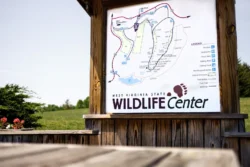Family: Percidae
Common Family: The Perch Family
Common Name: Saugeye (Walleye x Sauger Hybrid)
Scientific Name: Stizostedion vitreum x S. canadense
Ecological Description/Identification
Saugeye are similar to sauger in appearance. The best way to identify a fish that you feel may be either a walleye, sauger or saugeye is to look at the fish’s spiny dorsal fin. Walleye will have a rather large black blotch on the fins rear quarter and no dark fin coloration elsewhere; sauger will have rows of small dark spots on this fin, and saugeye will have dark coloration throughout the webbing on this dorsal fin. This coloration in a saugeye will have no set pattern.
Habitat
Saugeye were stocked into selected West Virginia reservoirs starting in 1990. However, these waters were changed to walleye fingerling stockings in 2002. Saugeye may be still be found in the following U. S. Army Corps of Engineers Reservoirs: Burnsville, East Lynn, and Beech Fork and are also caught in the Ohio and Kanawha rivers. They typically are more tolerant of warm water than walleye and may be more suited to life in turbid reservoirs. Saugeye often run upriver in winter and spring and congregate in tailwater areas below dams.
Conservation Issues
Saugeye are produced at fish hatcheries. Female walleyeare crossed with male sauger which result in a hybrid known as saugeye. They must be stocked routinely in order to maintain fishable populations. At this time, WVDNR is currently not stocking them, but fish remain at certain locations from past stockings.
Facts
Saugeye, like their parent species, walleye and sauger feed primarily on other fish. Fishing techniques are similar to those used for sauger and walleye. Use walleye fishing techniques when fishing in reservoirs and sauger techniques while fishing on rivers. The WV state length record saugeye is 27.68 inches and 8.73 lbs. (Evert Chapman, 2006).
Similar Species
As a product of female walleye and male sauger, saugeye have similarities to both fish in coloration. They are part of the perch family, which are small stream dwellers.



